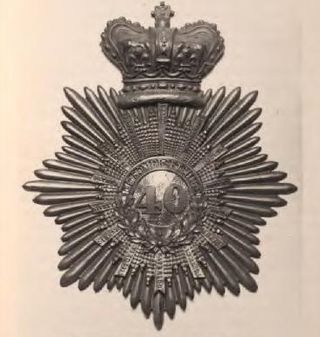
The South Lancashire Regiment was a line infantry regiment of the British Army in existence from 1881 to 1958.

General James Stuart was a British Army officer who served in North America during the American Revolutionary War and took part in various campaigns in British India. He was the first General Officer Commanding, Ceylon and second Military Governor of British Ceylon. He was appointed on 1 March 1796 and was Governor until 1 January 1797. He was succeeded by Welbore Ellis Doyle.

The 72nd Highlanders was a British Army Highland Infantry Regiment of the Line. Raised in 1778, it was originally numbered 78th, before being redesignated the 72nd in 1786. Under the Childers Reforms it amalgamated with the 78th (Highlanders) Regiment to form the 1st Battalion of the Seaforth Highlanders in 1881.
The 69th Regiment of Foot was an infantry regiment of the British Army, raised in 1756. Under the Childers Reforms it amalgamated with the 41st (Welch) Regiment of Foot to form the Welch Regiment in 1881.

The 40th Regiment of Foot was an infantry regiment of the British Army, raised in 1717 in Annapolis Royal, Nova Scotia. Under the Childers Reforms it amalgamated with the 82nd Regiment of Foot to form the Prince of Wales's Volunteers in 1881.
The 41st (Welch) Regiment of Foot was an infantry regiment of the British Army, raised in 1719. Under the Childers Reforms it amalgamated with the 69th Regiment of Foot to form the Welch Regiment in 1881.
The 82nd Regiment of Foot (Prince of Wales's Volunteers) was an infantry regiment of the British Army, raised in 1793. Under the Childers Reforms it amalgamated with the 40th (the 2nd Somersetshire) Regiment of Foot to form the Prince of Wales's Volunteers (South Lancashire Regiment) in 1881.
The 100th Regiment of Foot, or the Loyal Lincolnshire Regiment, was an infantry regiment of the British Army, formed in 1780 and disbanded in 1785. The Loyal Lincolnshire Regiment was reformed in 1794 as the 123rd Regiment of Foot and was again disbanded in 1796.
The 75th Regiment of Foot (Invalids) was an infantry regiment of the British Army from 1762 to 1768. It was originally raised as a regiment of invalids in June 1762, by John Lind, and numbered the 118th Foot; it was renumbered as the 75th the following year, and disbanded in 1768 or 1769.
The 74th Regiment of Foot (Invalids) was an infantry regiment of the British Army from 1762 to 1768.
The 73rd Regiment of Foot (Invalids) was an infantry regiment of the British Army from 1762 to 1768.
Four regiments of the British Army have been numbered the 71st Regiment of Foot:
82nd Regiment of Foot may refer to one of three regiments of the British Army that have been numbered the 82nd Regiment of Foot
The 83rd Regiment of Foot was a British Army line infantry regiment, which was formed in Ireland in 1793 for service in the French Revolutionary Wars. The regiment served in the West Indies, South Africa and the Peninsular War, and after the end of the wars with France spent much of the nineteenth century in colonial garrisons. Among other service, the 83rd fought in the Ceylon Great Rebellion of 1817–18, the Canadian Rebellions of 1837, and the Indian Rebellion of 1857. Under the Childers Reforms, the regiment amalgamated with the 86th Regiment of Foot to form the Royal Irish Rifles in 1881.
The 82nd Regiment of Foot was a British army regiment raised for service in the American Revolutionary War.
The 98th Regiment of Foot was an infantry regiment of the British Army. It was originally raised in 1824 as the 98th Regiment of Foot, before assuming the title of the 98th Regiment of Foot in 1876. Later, in 1881, following the Childers Reforms of the British Army, the regiment was amalgamated with the 64th Regiment of Foot to become the Prince of Wales's Regiment. As the 64th Foot was senior to the 98th, the 98th became the 2nd Battalion in the new regiment. Throughout the course of the regiment's existence it served mostly overseas in South Africa, China and India.
Four regiments of the British Army have been numbered the 73rd Regiment of Foot:
The 74th Regiment of (Highland) Foot or 74th Regiment of Foot (Argylshire Highlanders) was a British Army line infantry regiment from 1777 to 1784 which was raised to fight in the American Revolutionary War.
Five regiments of the British Army have been numbered the 72nd Regiment of Foot:



